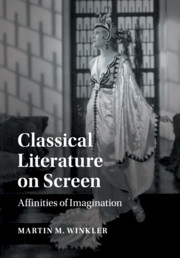Book contents
- Classical Literature on Screen
- Classical Literature on Screen
- Copyright page
- Contents
- List of Illustrations
- Acknowledgments
- Additional material
- Additional material
- Introduction
- Part I Creative Affinities
- Part II Elective Affinities
- Part III Non-elective Affinities
- Part IV Counter-Affinities
- Part V Aesthetic Affinities
- Bibliography
- Index
- References
Bibliography
Published online by Cambridge University Press: 12 September 2017
- Classical Literature on Screen
- Classical Literature on Screen
- Copyright page
- Contents
- List of Illustrations
- Acknowledgments
- Additional material
- Additional material
- Introduction
- Part I Creative Affinities
- Part II Elective Affinities
- Part III Non-elective Affinities
- Part IV Counter-Affinities
- Part V Aesthetic Affinities
- Bibliography
- Index
- References
- Type
- Chapter
- Information
- Classical Literature on ScreenAffinities of Imagination, pp. 366 - 404Publisher: Cambridge University PressPrint publication year: 2017



